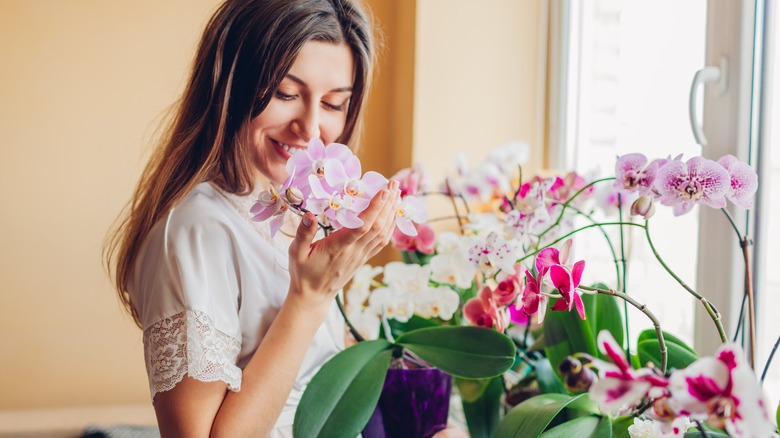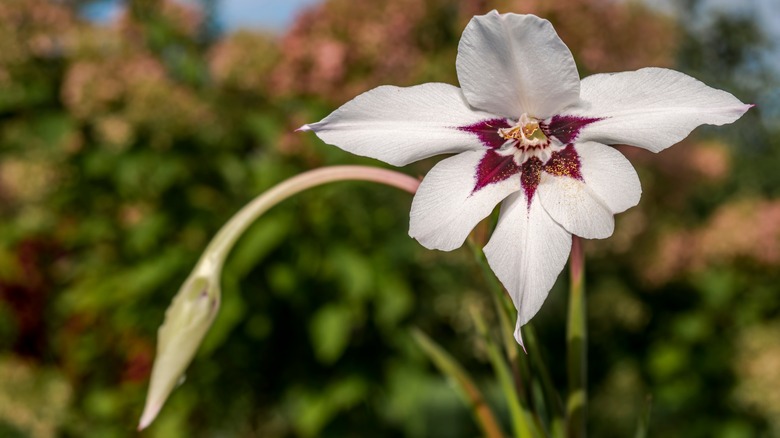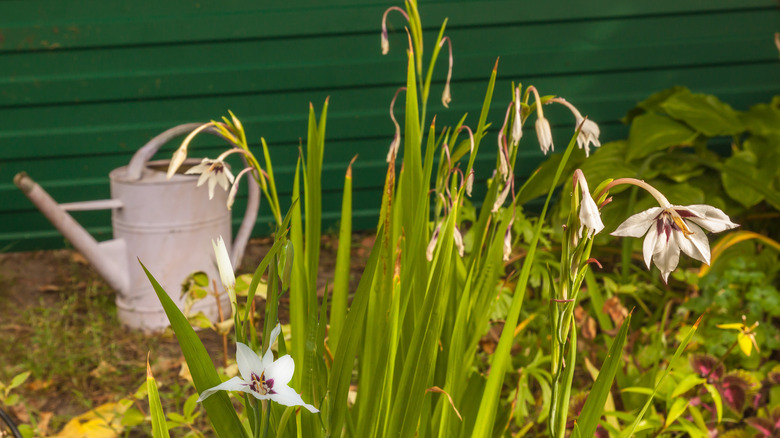The Summertime Flowering Bulb You Should Plant If You Love Orchids
Orchids are one of the most common potted flowers to see as you pass the floral department at the grocery store. They make beautiful gifts and give any room a pop of color and texture. If you're someone who can't help but grab an orchid or two when you're out, there's a summertime bulb you may want to add to your garden. Peacock orchids (Gladiolus murielae) feature star-shaped white flowers with maroon centers and tall, sword-shaped green foliage. Although they look similar to orchids, they're one of the members of the gladiolus genus. Unlike orchids, which grow from pseudobulbs, peacock orchids grow from globose corms. Both of these are essentially nutrient storage spheres, though corms grow underground, and pseudobulbs grow underneath the plant's leaves. Their corms multiply during the growing season, so you can divide them when the weather cools down and propagate them the next year.
Peacock orchids are medium-sized plants that grow to be 2-3 feet tall, so they're perfect for adding a little height to your garden. The flowers also have a sweet, pleasant fragrance (similar to jasmine) that can fill your garden with an aroma that may bring more pollinators to your garden. Despite their exotic appearance, peacock orchids are surprisingly easy to grow and care for. Let's dive into what makes peacock orchids the perfect summertime bulb for orchid lovers and how to care for them.
Why peacock orchids make a great orchid alternative
Although not impossible, growing true orchids outside can be a little challenging. Because true orchids are tropical plants, most species prefer climates with high temperatures, consistent rainfall, and lots of humidity, which can be challenging to replicate in most areas. The most common variety you'll find in grocery stores is the moth orchid (Phalaenopsis amabilis), which is only hardy in the southernmost parts of the United States, in zones 10-12. You may know them as beginner orchids, but they're more novice-friendly if you're caring for them as houseplants. On the other hand, peacock orchids are a bit more cold-hardy and can live outside in hardiness zones 7-11. If you live in zones that get colder than 10 degrees Fahrenheit in the winter, you can bring them indoors for overwintering.
Peacock orchids make a great orchid alternative to the garden with their similarly eye-catching and unique flower petal arrangement. Even if you live in a hardiness zone where true orchids flourish, a few peacock orchids can switch up the floral display and breathe new life into your garden. Their blooms emerge in late summer, lasting all the way to fall, depending on if you start them indoors and when you plant them. Even better, their relatively easy care means these are flowers even the worst gardener can handle. However, it's important to note that all parts of the Gladiolus muriela plant, especially the corms, are toxic to cats, dogs, and horses.
How to grow and care for the peacock orchid
Peacock orchids do best when you plant the corms after there's no longer a risk of frost. However, you can start them a few weeks early and transplant them when it warms up outside. Although their stalks are somewhat sturdy, areas with strong wind can be damaging. So, it's best to either plant them in a location where they'll have protection against big gusts, or you may need to stake them. Rather than growing them in rows, plant them in clusters of at least five. Dig a hole that's 2-6 inches deep, depending on the size of the corms (big ones should be planted deeper into the soil.) Make sure there's a distance of 4-6 inches between each bulb.
They'll need a bit of extra water during the growing season, so keep the soil evenly moist without letting it dry out. Once they begin flowering, you can reduce the watering. Peacock orchids like organically rich, well-draining soil and will not tolerate clay soils. You'll get the largest and prettiest blooms when you give them full sun conditions; part shade will result in smaller flowers. For added texture in your garden, plant them next to soft, airy grasses like prairie dropseed (Sporobolus heterolepis). If you want to bring out their merlot splotches, they pair beautifully next to red or purple flowers. For example, China aster (Callistephus chinensis), which has a similar blooming season and growth conditions as peacock orchids, comes in several shades, including burgundy.


